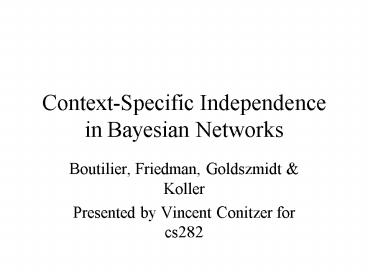ContextSpecific Independence in Bayesian Networks - PowerPoint PPT Presentation
1 / 12
Title:
ContextSpecific Independence in Bayesian Networks
Description:
... inferring local CSI. Context-Specific ... Compact Representation through CSI (1) ... But with CSI, we can remove more edges for some instantiation: ... – PowerPoint PPT presentation
Number of Views:75
Avg rating:3.0/5.0
Title: ContextSpecific Independence in Bayesian Networks
1
Context-Specific Independence in Bayesian Networks
- Boutilier, Friedman, Goldszmidt Koller
- Presented by Vincent Conitzer for cs282
2
Part 1 -- Setup
- Context-specific independence introduction
- Local CSI
- Tree representation of CPTs
- Using the tree representation for inferring local
CSI
3
Context-Specific Independence
- Wheres Waldo example
- Would like to be able to conclude I(Wet, Rain
in ParisWWLondon), but not I(Wet, Rain in
ParisWWParis) -- the independence is
context-specific
Rain in London
Rain in Paris
Wheres Waldo
Waldo Wet
4
Local CSIs
- Local CSIs indicate which of the parents you
dont need to know to instantiate the child in a
context - In the context, the edge between such a parent
and the child is then called vacuous - In order to find out about independence in a
context, just use d-separation on the network
after removing vacuous edges (CSI-separation) - CSI-separation gives the strongest CSI
conclusions possible given just the local CSIs
5
How should we represent CPTs?
- We want to represent our CPTs in a way which
allows for easy recognition of local CSIs.
Authors focus on decision trees, or CPT-trees.
E.g. tree for Waldo Wet - Note that the structure of the second tree
intuitively does not seem to represent I(Wet,
Rain in LWWP)
Wheres Waldo
Rain in London
OR
N
Y
L
P
Wheres Waldo
Wheres Waldo
Rain in Paris
Rain in London
P
P
L
L
Rain in Paris
Rain in Paris
N
N
Y
Y
N
Y
N
Y
0
.8
0
.9
0
0
.9
0
.8
.9
6
Reducing CPTs in a Context
- To reduce a CPT given a context, we cut out all
the decision nodes that are known, and their
subtrees corresponding to values other than the
instantiation - Variable eliminated from tree its edge is
vacuous - This method is complete given only the tree
structure
Wheres Waldo
Rain in London
OR
N
Y
L
P
Wheres Waldo
Wheres Waldo
Rain in Paris
Rain in London
P
P
L
L
Rain in Paris
Rain in Paris
N
N
Y
Y
N
Y
N
Y
0
.8
0
.9
0
0
.9
0
.8
.9
7
Part 2 -- Inference
- Inference through compactifying the network
- Inference through clustering
8
Compact Representation through CSI (1)
- We can use the information from the CSIs to come
up with a more compact representation of the
network, as in noisy-OR models etc., for faster
inference - Idea condition on one parent to create values,
then instantiate parent and pick the appropriate
value
Rain in Paris
Rain in London
2
2
Wheres Waldo
WetWWP
WetWWL
Wet
9
Compact Representation through CSI (2)
- If previous does not use all the structure from
the CPT tree, can repeat. E.g. suppose we use the
bad tree
Rain in Paris
2
Step 2
Step 1
1
(WetRL T) WW P
1
2
Wheres Waldo
Rain in Paris
(WetRL F) WW L
(WetRL T) WW L
(WetRL F) WW P
4
4
WetRL F
WetRL T
Wheres Waldo
Wheres Waldo
Rain in London
WetRL T
Rain in London
WetRL F
Wet
Wet
10
Clustering with CSI (1)
- The idea of clustering is to instantiate
variables, remove outgoing edges, and continue.
But with CSI, we can remove more edges for some
instantiation - Normally, would need to instantiate 2 variables
to get a polytree. But now we only need the Where
variable.
Rain in London
Where is couple
Rain in Paris
Waldo Wet
Wilda Wet
11
Clustering with CSI (2)
- How do we pick which variable to instantiate
first? Naïve greedy pick one which on average
removes the most edges. But consider - Want to instantiate left two first -- this will
always give a polytree. But instantiating only
one helps nothing.
Rain in London
Waldo Left Seat
Rain in Paris
Waldo Driver
Waldo Wet
Wilda Wet
12
Clustering with CSI (3)
- Solution look at reduced tree sizes.
Waldo Left Seat
Waldo Driver
Waldo Driver
Eliminating one of the top two variables leaves a
smaller number of probabilities in the tree,
suggesting they are better for instantiation.
Rain in London
Rain in Paris
Rain in Paris
Rain in London































